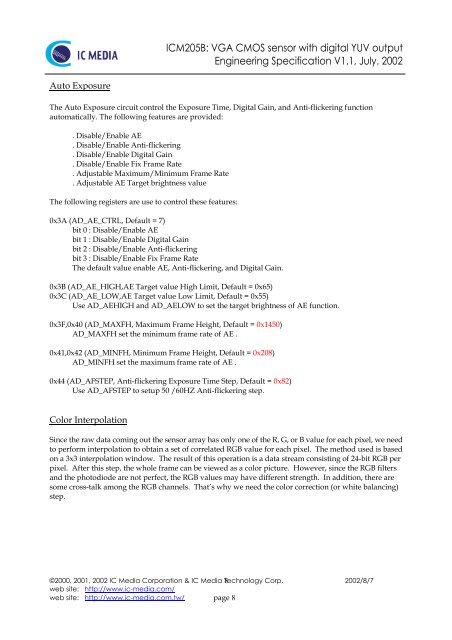ICM205B VGA/QVGA CMOS image sensor with digital YUV output ...
ICM205B VGA/QVGA CMOS image sensor with digital YUV output ...
ICM205B VGA/QVGA CMOS image sensor with digital YUV output ...
You also want an ePaper? Increase the reach of your titles
YUMPU automatically turns print PDFs into web optimized ePapers that Google loves.
Auto Exposure<br />
<strong>ICM205B</strong>: <strong>VGA</strong> <strong>CMOS</strong> <strong>sensor</strong> <strong>with</strong> <strong>digital</strong> <strong>YUV</strong> <strong>output</strong><br />
Engineering Specification V1.1, July. 2002<br />
The Auto Exposure circuit control the Exposure Time, Digital Gain, and Anti-flickering function<br />
automatically. The following features are provided:<br />
. Disable/Enable AE<br />
. Disable/Enable Anti-flickering<br />
. Disable/Enable Digital Gain<br />
. Disable/Enable Fix Frame Rate<br />
. Adjustable Maximum/Minimum Frame Rate<br />
. Adjustable AE Target brightness value<br />
The following registers are use to control these features:<br />
0x3A (AD_AE_CTRL, Default = 7)<br />
bit 0 : Disable/Enable AE<br />
bit 1 : Disable/Enable Digital Gain<br />
bit 2 : Disable/Enable Anti-flickering<br />
bit 3 : Disable/Enable Fix Frame Rate<br />
The default value enable AE, Anti-flickering, and Digital Gain.<br />
0x3B (AD_AE_HIGH,AE Target value High Limit, Default = 0x65)<br />
0x3C (AD_AE_LOW,AE Target value Low Limit, Default = 0x55)<br />
Use AD_AEHIGH and AD_AELOW to set the target brightness of AE function.<br />
0x3F,0x40 (AD_MAXFH, Maximum Frame Height, Default = 0x1450)<br />
AD_MAXFH set the minimum frame rate of AE .<br />
0x41,0x42 (AD_MINFH, Minimum Frame Height, Default = 0x208)<br />
AD_MINFH set the maximum frame rate of AE .<br />
0x44 (AD_AFSTEP, Anti-flickering Exposure Time Step, Default = 0x82)<br />
Use AD_AFSTEP to setup 50 /60HZ Anti-flickering step.<br />
Color Interpolation<br />
Since the raw data coming out the <strong>sensor</strong> array has only one of the R, G, or B value for each pixel, we need<br />
to perform interpolation to obtain a set of correlated RGB value for each pixel. The method used is based<br />
on a 3x3 interpolation window. The result of this operation is a data stream consisting of 24-bit RGB per<br />
pixel. After this step, the whole frame can be viewed as a color picture. However, since the RGB filters<br />
and the photodiode are not perfect, the RGB values may have different strength. In addition, there are<br />
some cross-talk among the RGB channels. That’s why we need the color correction (or white balancing)<br />
step.<br />
©2000, 2001, 2002 IC Media Corporation & IC Media Technology 8<br />
Corp. 2002/8/7<br />
web site: http://www.ic-media.com/<br />
web site: http://www.ic-media.com.tw/ page 8



